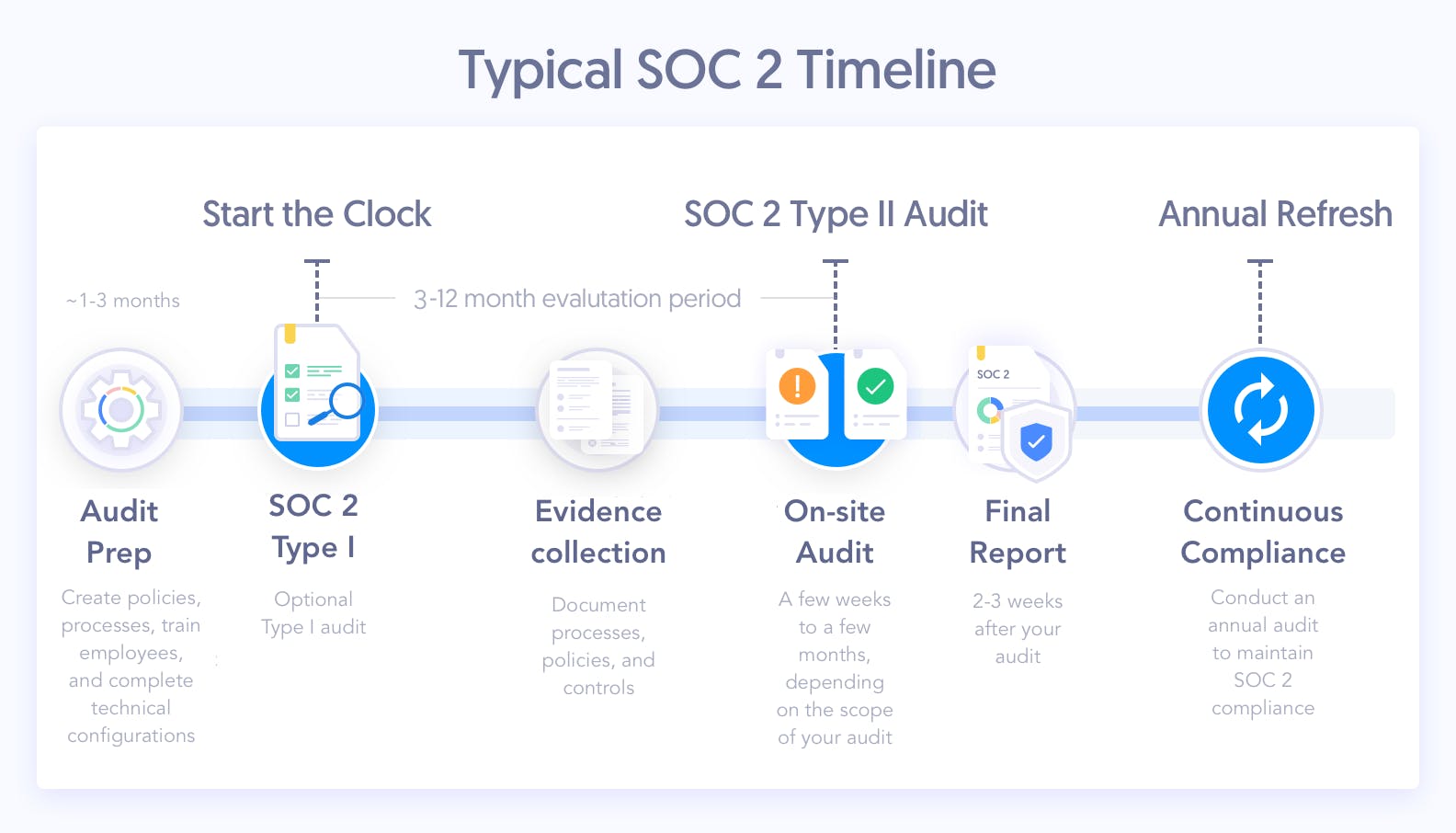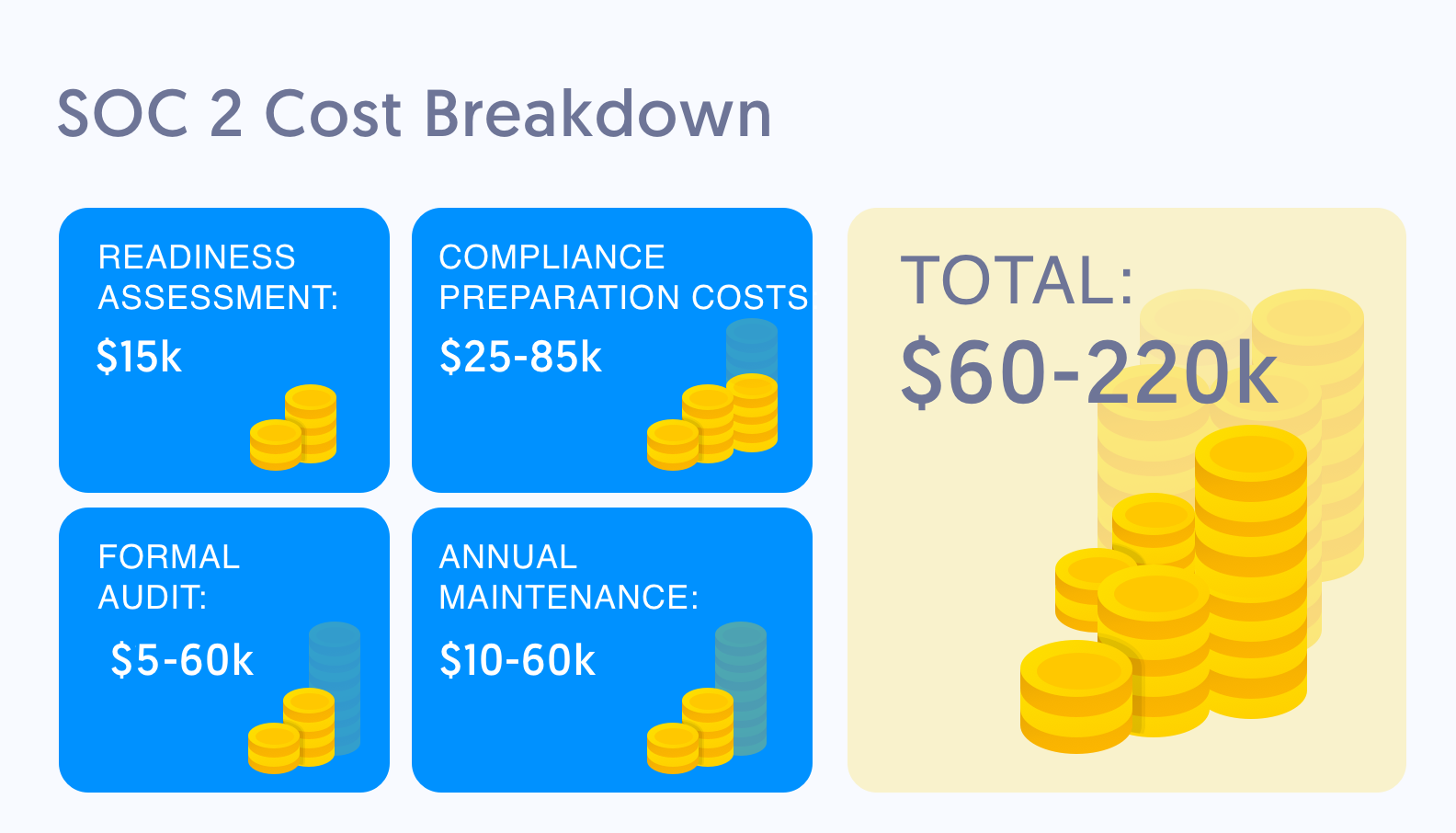A SOC 2 report requires a substantial investment of time, money, and effort to achieve — but it doesn’t have to be so costly. Automation can slash the time and money needed to achieve compliance by making the entire process more efficient.
In this article, we'll estimate the average time and costs of SOC 2 compliance when taking a manual approach. Then we'll look at how automation can reduce that time and costs using data from a survey of Secureframe users.
How Long Does a SOC 2 Audit Take Without Automation?
Because SOC 2 audits require so much upfront work, it’s worth breaking the process down into pre-audit prep and the audit itself.
The pre-audit phase typically lasts 2-9 months, consisting of:
- Scoping your audit
- Evaluating your systems
- Conducting a gap analysis
- Implementing new controls
- Training your employees
- Writing new policies and procedures
- Compiling the necessary documentation
- Completing a readiness assessment
The formal audit itself can take between 1-3 months, depending on the scope and complexity of your audit. And the number of additional evidence requests and control tests your auditor has to issue.
The auditor will gather and review all of your evidence documentation, interview members of your team, and finally issue your formal SOC 2 report.
Altogether, most organizations are able to complete a SOC 2 Type I report in 1-4 months. A SOC 2 Type II report can be completed in 3-12 months.

How Much Does a SOC 2 Audit Cost Without Automation?
The cost of a SOC 2 audit varies. It depends on:
- The size of your company
- Whether you’re pursuing a Type I or a Type II report
- The scope and complexity of your audit
- The level of prestige of your auditing firm
On average, companies can expect to pay between $10-60k for the audit alone.
In addition to the formal audit, SOC 2 costs often include:
Readiness Assessments
A readiness assessment determines how ready your organization is for a successful SOC 2 audit. It will also help you spot potential gaps in your controls and create a plan for fixing them. A professional SOC 2 readiness assessment costs between $10-17k, depending on the size of your organization and the scope of your audit.
Security Tools and Training
Fixing gaps in your data management system can mean purchasing new security tools. You might also need to invest in employee security training or even hire more employees.
Consulting Fees
Some companies without an internal compliance team choose to hire a consultant. These security consultants can help conduct a gap analysis, remediation plan, and assist in audit prep. If you choose to hire a consultant, expect to pay an additional $25-85k depending on the scope of your systems.
Between preparation and the audit itself, the total cost of achieving SOC 2 compliance can land between $60k and over $100k. And because SOC 2 reports need to be renewed on an annual basis, many of these are recurring costs.

Why Automation is a Game-Changer for SOC 2 Audits
Secureframe’s compliance automation streamlines the entire SOC 2 audit process, saving teams hundreds of hours and thousands of dollars spent writing security policies, collecting evidence, hiring security consultants, and performing readiness assessments.
Some of our customers have prepared for a successful SOC 2 audit in just a few weeks, but the benefits of compliance automation go beyond time savings.
In a survey conducted by UserEvidence, Secureframe users reported a range of benefits, including:
- 97% strengthened their security and compliance posture
- 95% saved time and resources obtaining and maintaining compliance
- 89% sped up time-to-compliance for multiple frameworks
- 85% unlocked annual cost savings
- 71% improved visibility into security and compliance posture
Let's take a closer look at these benefits of Secureframe's compliance automation solution below.
Strengthens your security and compliance posture
With Secureframe, you understand exactly what you need to do to meet SOC 2 requirements and track your progress towards being audit-ready. You’ll get a real-time view of what’s looking good and what you can do to improve before bringing in your auditor.
You can also leverage our team of in-house compliance experts, which has decades of audit advisory and consulting experience. They understand your company’s specific requirements, provide tailored advice for an ironclad security posture, and guide you through a successful audit.
Saves time and resources
If your organization relies on a manual approach to compliance, you’ll need to:
- Collect screenshots and documentation for evidence over and over for each SOC 2 audit
- Track dozens of tasks in spreadsheets, some of which need to be performed annually, quarterly, or on another recurring basis to maintain compliance
- Complete thorough risk assessments and gap analyses regularly as your business grows and industry standards evolve
- Create a risk register and asset inventory in spreadsheets and keep those up-to-date
- Write SOC 2 policies from scratch and ensure they stay updated and that employees review them as they onboard and at least annually after that
- Monitor your controls and infrastructure to identify any issues and remediate them as quickly as possible
As your organization spends more resources on repetitive manual tasks like these, the complexity and costs of a security compliance program rise sharply. Secureframe automates these manual tasks, reducing the time and resources it takes for your organization to achieve and maintain SOC 2 compliance.
Speeds up time-to-compliance for multiple frameworks
As your compliance program expands beyond SOC 2, Secureframe can help reduce the time and effort required to comply with multiple frameworks. Secureframe automatically maps the control set and underlying tests of the SOC 2 framework to the requirements of another framework. By doing so, organizations don’t have to waste valuable time and resources creating independent sets of controls, performing redundant tests, gathering the same evidence, and repeating other activities to comply with multiple frameworks that have common controls.
That means, if you add a new framework to your Secureframe instance, you will automatically see where you stand with that framework and how it overlaps with SOC 2. Due to such common overlap across frameworks, existing Secureframe customers adding new frameworks never start at 0% when adding a new framework to their instance.
Unlocks cost savings
Compliance is an extremely cross-functional practice, where the assets under scope span multiple teams, including engineering, security, compliance, leadership, risk, IT, and HR. As a result, many compliance activities are performed by various teams that actually own the assets in question. This is why typical compliance automation software has focused on automating workflow aspects around cross-functional collaboration, such as ticket lifecycle management, cross-functional control ownership, alerting, and reporting.
However, Secureframe acts as an all-in-one solution and removes the need for many of these compliance activities to be human exercises at all. By reducing the amount of manual work that teams need to perform, Secureframe drastically lowers workflow and collaboration requirements, which leads to massive cost savings across the entire compliance function.
Improves visibility into your security and compliance posture
From your cloud infrastructure to your vendor ecosystem, we continuously scan and monitor your tech stack and alert you of vulnerabilities. This helps you get your SOC 2 report faster and stay compliant.
This automated continuous monitoring, combined with deep integrations and dashboards, provides your organization to with a holistic view of your compliance management program so you can see how your SOC 2 controls are performing over time and if there are any non-conformities or compliance issues across your tech stack.
Thousands of companies trust Secureframe to streamline SOC 2 compliance. Read some of their success stories.
About the UserEvidence Survey
The data about Secureframe users was obtained through an online survey conducted by UserEvidence in February 2024. The survey included responses from 44 Secureframe users (the majority of whom were manager-level or above) across the information technology, consumer discretionary, industrials, financial, and healthcare industries.